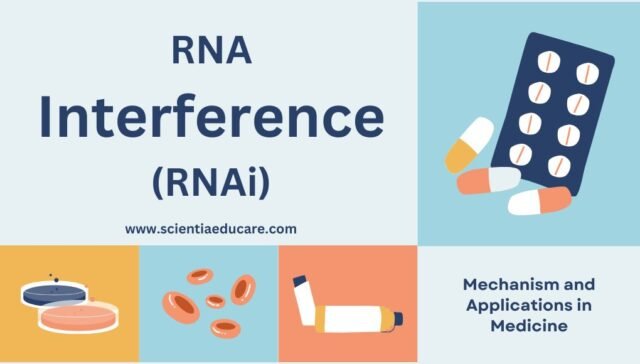RNA Interference (RNAi): Mechanism and Revolutionary Applications in Modern Medicine
Introduction
RNA interference (RNAi) is a crucial biological process that regulates gene expression by inhibiting or silencing specific messenger RNA (mRNA) molecules. Discovered in the late 1990s, RNAi has emerged as a powerful tool for studying gene function and holds immense therapeutic potential in medicine. This module explores the mechanism of RNAi, its applications in medicine, and the future prospects of RNA-based therapies.
How RNAi works in medicine,
RNA interference therapy benefits,
Gene silencing with RNAi,
RNAi for rare diseases,
Medical applications of RNAi.
Mechanism of RNA Interference (RNAi)
The RNAi mechanism is a post-transcriptional gene silencing process that operates through small RNA molecules, mainly small interfering RNA (siRNA) and microRNA (miRNA). These molecules guide the RNA-induced silencing complex (RISC) to target mRNA, leading to degradation or translation repression.
Steps in the RNAi Pathway:
- Initiation Stage
- Double-stranded RNA (dsRNA) or precursor miRNA enters the cell.
- Dicer, an RNase III enzyme, cleaves dsRNA into small RNA fragments (~21-25 nucleotides).
- Formation of RISC
- The generated siRNA or miRNA duplexes associate with the Argonaute (AGO) protein within the RISC complex.
- One strand (the guide strand) is retained, while the passenger strand is degraded.
- mRNA Target Recognition and Silencing
- The guide strand directs RISC to complementary mRNA.
- For siRNA, the mRNA is cleaved and degraded.
- For miRNA, translational repression or mRNA degradation occurs depending on sequence complementarity.
Applications of RNA Interference in Medicine
RNAi technology has revolutionized the medical field, enabling targeted gene silencing for therapeutic and research applications. Below are some key medical applications:
1. Therapeutics for Genetic Disorders
- RNAi therapy is used to silence genes responsible for genetic diseases.
- Example: Patisiran (Onpattro) – FDA-approved RNAi drug for hereditary transthyretin-mediated amyloidosis (hATTR).
2. Cancer Treatment
- RNAi can silence oncogenes involved in tumor development.
- Example: siRNA-based therapy targeting KRAS or VEGF in various cancers.
- RNAi enhances chemotherapy sensitivity and reduces side effects.
3. Antiviral Strategies
- RNAi can be used to target viral RNA, preventing viral replication.
- Example: RNAi-based approaches against Hepatitis B, HIV, and Influenza.
4. Neurodegenerative Diseases
- RNAi helps in the downregulation of toxic protein accumulation.
- Example: Huntington’s disease – RNAi reduces mutant huntingtin (HTT) expression.
- Potential treatments for Parkinson’s and Alzheimer’s diseases.
5. Treatment of Metabolic Disorders
- RNAi regulates cholesterol metabolism and insulin resistance.
- Example: Inclisiran, an RNAi-based drug for lowering LDL cholesterol by targeting PCSK9.
6. Ophthalmology
- RNAi therapy is used for retinal diseases such as age-related macular degeneration (AMD).
- Example: Bevasiranib – siRNA targeting VEGF in AMD treatment.
7. Infectious Disease Control
- RNAi can suppress bacterial and viral infections by silencing pathogen-related genes.
- Research is ongoing in COVID-19 RNAi-based treatments.
Challenges and Limitations of RNAi in Medicine
While RNAi-based therapies show immense promise, there are several challenges:
1. Delivery Mechanisms
- Effective delivery of RNA molecules to target tissues remains a challenge.
- Solutions: Lipid nanoparticles (LNPs) and viral vectors.
2. Off-Target Effects
- RNAi can sometimes silence unintended genes, leading to side effects.
- Solution: Designing highly specific siRNAs.
3. Stability of RNA Molecules
- RNA molecules are rapidly degraded in the bloodstream.
- Solution: Chemical modifications like 2′-O-methyl modifications for stability.
4. Immune Response
- RNAi triggers an immune response, causing inflammation.
- Solution: Optimization of RNA sequences to minimize immune activation.
Future Prospects of RNAi in Medicine
With rapid advancements in gene therapy, nanotechnology, and drug delivery systems, the future of RNAi in medicine looks promising. Ongoing research aims to:
- Improve RNAi target specificity and efficiency.
- Develop novel delivery systems for precise drug administration.
- Expand RNAi applications in personalized medicine and regenerative therapy.
Relevant Website URL Links
For more detailed information on RNA interference, visit:
- National Center for Biotechnology Information (NCBI)
- Nature – RNA Interference
- FDA – RNAi Therapeutics
- Alnylam Pharmaceuticals – RNAi Therapies
Further Reading
If you’re interested in learning more about RNA interference, check out these resources:
- Cold Spring Harbor Laboratory RNAi Resource
- MIT OpenCourseWare – RNA Biology
- ScienceDirect – RNA Interference Studies
Conclusion
RNA interference is a revolutionary tool in modern medicine, offering highly targeted gene silencing for treating genetic disorders, cancers, metabolic conditions, and viral infections. With ongoing research and advancements in drug delivery, RNAi-based therapies are expected to transform personalized medicine, providing safer and more effective treatments for a wide range of diseases.
MCQs on “RNA Interference (RNAi): Mechanism and Applications in Medicine”
Basic Concept of RNA Interference (RNAi)
-
What is RNA interference (RNAi)?
a) A process that increases protein synthesis
b) A mechanism for post-transcriptional gene silencing
c) A method of enhancing DNA replication
d) A pathway for synthesizing new RNA moleculesAnswer: b) A mechanism for post-transcriptional gene silencing
Explanation: RNAi is a biological process where RNA molecules inhibit gene expression by neutralizing targeted mRNA molecules, leading to gene silencing. -
Which of the following molecules primarily mediate RNA interference?
a) tRNA and rRNA
b) siRNA and miRNA
c) mRNA and DNA
d) Ribosomal RNA and ProteinsAnswer: b) siRNA and miRNA
Explanation: Small interfering RNA (siRNA) and microRNA (miRNA) are the key molecules involved in RNAi, regulating gene expression post-transcriptionally. -
What is the primary function of small interfering RNA (siRNA) in RNAi?
a) Enhancing gene expression
b) Blocking ribosome attachment to mRNA
c) Cleaving specific mRNA molecules
d) Promoting transcriptionAnswer: c) Cleaving specific mRNA molecules
Explanation: siRNAs guide the RNA-induced silencing complex (RISC) to cleave complementary mRNA, preventing translation. -
How is microRNA (miRNA) different from small interfering RNA (siRNA)?
a) miRNA forms perfect base-pairing with target mRNA, whereas siRNA binds imperfectly
b) siRNA is endogenous, whereas miRNA is exogenous
c) miRNA usually inhibits translation, while siRNA degrades mRNA
d) miRNA is double-stranded, whereas siRNA is single-strandedAnswer: c) miRNA usually inhibits translation, while siRNA degrades mRNA
Explanation: miRNA generally binds imperfectly to mRNA and suppresses translation, whereas siRNA binds perfectly and leads to degradation. -
Which enzyme processes double-stranded RNA (dsRNA) into siRNA in the RNAi pathway?
a) RNA polymerase
b) Cas9
c) Dicer
d) DNA ligaseAnswer: c) Dicer
Explanation: Dicer is an RNase III enzyme that cleaves long dsRNA into short siRNA fragments.
Mechanism of RNA Interference
-
Which protein complex is responsible for binding siRNA and guiding mRNA degradation?
a) RNA Polymerase
b) RISC (RNA-Induced Silencing Complex)
c) Reverse Transcriptase
d) DNA HelicaseAnswer: b) RISC (RNA-Induced Silencing Complex)
Explanation: RISC is a multi-protein complex that incorporates siRNA and mediates mRNA cleavage. -
Which of the following serves as the guide strand in RISC?
a) The sense strand of siRNA
b) The antisense (complementary) strand of siRNA
c) The entire double-stranded siRNA
d) Ribosomal RNAAnswer: b) The antisense (complementary) strand of siRNA
Explanation: The antisense strand binds to complementary mRNA and directs its cleavage by RISC. -
Which cellular process is targeted by RNAi?
a) DNA replication
b) Post-transcriptional gene expression
c) Protein folding
d) MitosisAnswer: b) Post-transcriptional gene expression
Explanation: RNAi silences genes at the mRNA level after transcription but before translation.
Applications of RNAi in Medicine
-
Which of the following diseases is being targeted for treatment using RNAi-based therapy?
a) Alzheimer’s disease
b) Cancer
c) Viral infections
d) All of the aboveAnswer: d) All of the above
Explanation: RNAi is being explored for treating neurodegenerative diseases, cancer, and viral infections by silencing disease-related genes. -
What is the main challenge in using RNAi therapeutically?
a) High stability of siRNA in cells
b) Difficulty in delivering siRNA to target cells
c) RNAi does not work in humans
d) Excessive protein synthesis
Answer: b) Difficulty in delivering siRNA to target cells
Explanation: Delivering siRNA effectively without degradation is a major challenge in RNAi-based therapies.
- Which RNAi-based drug was the first to be approved by the FDA?
a) Onpattro (Patisiran)
b) Remdesivir
c) Penicillin
d) Tamiflu
Answer: a) Onpattro (Patisiran)
Explanation: Patisiran was the first siRNA drug approved for treating hereditary transthyretin amyloidosis.
- RNAi technology is used in gene therapy to:
a) Silence harmful genes
b) Increase gene expression
c) Alter the DNA sequence permanently
d) Enhance viral infections
Answer: a) Silence harmful genes
Explanation: RNAi is used to suppress the expression of disease-causing genes.
Advanced and Research Aspects of RNAi
- Which of the following viruses can be targeted using RNAi technology?
a) HIV
b) Hepatitis B
c) Influenza
d) All of the above
Answer: d) All of the above
Explanation: RNAi has shown potential in silencing viral RNA in diseases like HIV, Hepatitis B, and Influenza.
- Which delivery method is commonly used for siRNA-based therapy?
a) Lipid nanoparticles
b) Plasmid DNA injection
c) Direct protein infusion
d) Electroporation
Answer: a) Lipid nanoparticles
Explanation: Lipid nanoparticles protect siRNA and enhance cellular uptake in therapeutic applications.
- Which Nobel Prize-winning discovery contributed to RNAi research?
a) Discovery of siRNA by Fire and Mello (2006)
b) CRISPR gene editing (2020)
c) Discovery of DNA structure (1962)
d) PCR technique (1993)
Answer: a) Discovery of siRNA by Fire and Mello (2006)
Explanation: Andrew Fire and Craig Mello received the Nobel Prize for discovering RNA interference in 2006.














